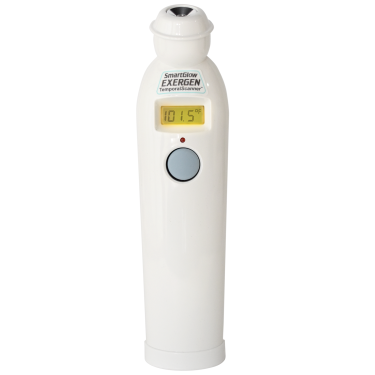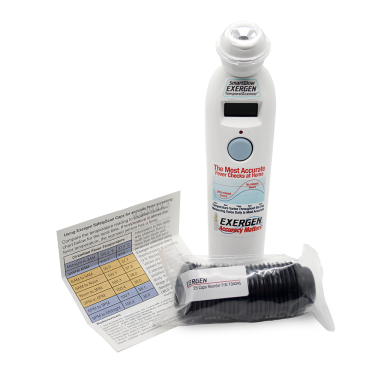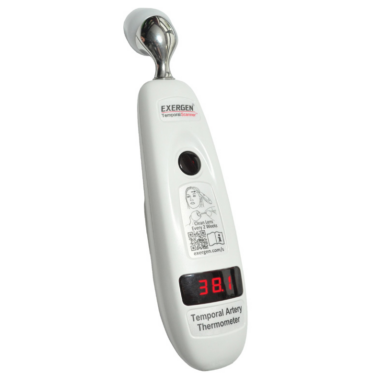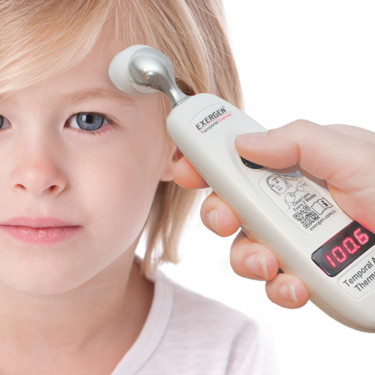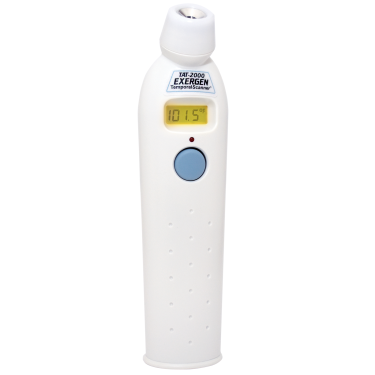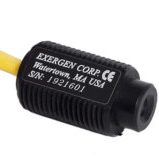Hospitalization is a critical aspect of healthcare, addressing a wide range of medical conditions that require immediate and often prolonged treatment. Among the most common reasons for hospital stays are conditions closely associated with fever, a key physiological response that often signals underlying infections, inflammatory diseases, and systemic disorders. Accurate temperature measurement, therefore, plays a crucial role in early diagnosis and patient management.
This whitepaper explores the most common causes of hospitalizations, the role fever plays in these conditions, and the importance of selecting the most reliable and comfortable temperature measurement methods, with a focus on Temporal Artery Thermometry (TAT) as pioneered by Exergen.
Common Reasons for Hospitalization
A 2021 report by the Kaiser Family Foundation (KFF) identified key reasons why people are hospitalized. Among these, maternal and neonatal stays accounted for 22% of hospitalizations, with Medicaid covering approximately 41% of births. The remaining hospitalizations were categorized as medical (50%), surgical (18%), injury-related (5%), and mental health or substance abuse-related (5%).
Leading Causes of Hospital Stays (Excluding Maternal and Neonatal Cases)
- Sepsis – 739 stays per 100,000
- COVID-19 – 468 stays per 100,000
- Heart Failure – 328 stays per 100,000
- Diabetes with Complications – 206 stays per 100,000
- Heart Attack – 177 stays per 100,000
- Arrhythmia – 174 stays per 100,000
- Ischemic Stroke – 162 stays per 100,000
- Acute and Unspecific Kidney Failure – 145 stays per 100,000
- Pneumonia – 138 stays per 100,000
- Urinary Tract Infection (UTI) – 134 stays per 100,000
Why Sepsis is Such an Important Cause for Hospital Stays
Sepsis is a serious medical condition that arises when the body’s response to infection leads to tissue damage, organ failure, or death. It occurs when the immune system’s reaction to an infection becomes dysregulated, causing widespread inflammation and impairing blood flow to vital organs. This can result in a cascade of complications, including septic shock and multiple organ dysfunction syndrome. 
Sepsis is a significant contributor to hospitalizations and in-hospital mortality rates. According to the Agency for Healthcare Research and Quality (AHRQ), sepsis-related hospital stays in the United States increased from 1.8 million in 2016 to 2.5 million in 2021, accounting for 7.5% of all inpatient stays in 2021. Furthermore, sepsis was responsible for 29.3% of all in-hospital deaths in 2021, highlighting its substantial impact on patient outcomes. 
The condition affects individuals across all age groups, but certain populations are at higher risk. Older adults, particularly those aged 65 and above, have experienced a 38.3% increase in sepsis-related hospitalizations between 2016 and 2021. Adults aged 18–64 years saw a 52.0% increase during the same period. Additionally, maternal sepsis cases rose by 60.9%, and sepsis-related stays for children aged 28 days and older increased by 16.4%.  
The emergence of COVID-19 has further complicated the landscape, with sepsis-related hospitalizations increasing by 16.5% from 2019 to 2021. The in-hospital mortality rate for sepsis also rose during this time, particularly among adults aged 65 and older, where it increased by 37.5%. 
Sepsis is not only a leading cause of death but also imposes a significant economic burden. In the United States, it is the most expensive condition treated in hospitals, with costs exceeding $23 billion annually. The average length of hospital stay for sepsis patients is approximately 75% longer than for other conditions, contributing to higher healthcare expenditures.  
Early recognition and prompt treatment are crucial in managing sepsis effectively. Initiatives like the “Sepsis Six” bundle, which includes administering antibiotics and intravenous fluids within the first hour of diagnosis, have been associated with improved patient outcomes. Despite these efforts, public awareness remains low, with a significant portion of the population unaware of sepsis symptoms, underscoring the need for continued education and prevention strategies. 
The Role of Fever in Hospitalizations
Fever is one of the most common symptoms associated with many of these conditions. It serves as an early warning sign of:
- Viral infections (e.g., COVID-19, influenza, pneumonia)
- Bacterial infections (e.g., sepsis, UTIs, bacterial pneumonia)
- Systemic inflammatory responses (e.g., heart failure complications, ischemic stroke, diabetes-related infections)
Because fever is a primary indicator of infection and disease progression, continuous and accurate body temperature monitoring is essential in hospital settings.
Comparing Temperature Measurement Methods in Hospitals
Hospitals utilize various methods to measure body temperature. Traditionally, oral, rectal, and axillary (underarm) thermometers were common, but advances in technology have introduced non-invasive alternatives such as in-ear thermometers and Temporal Artery Thermometers (TAT). Exergen, a leader in medical thermometry, played a pioneering role in both technologies but ultimately determined that in-ear thermometry presented significant ease of use and comfort challenges, leading to the development of superior Temporal Artery Thermometry.
In-Ear Thermometers
In-ear thermometers, also known as tympanic thermometers, measure infrared radiation from the eardrum to estimate body temperature. While this method can provide relatively quick readings, it has notable limitations:
- Accuracy issues: Incorrect placement or presence of earwax can distort readings, leading to false negatives or false positives.
- Patient discomfort: In-ear thermometry requires inserting a probe into the ear, which can be uncomfortable, especially for young children and elderly patients.
- Environmental influence: Cold environments, external ear infections, or incorrect angle placement may result in unreliable readings. –
- High recurring costs because of the use of caps (+ of course not really “green”
Exergen, the company that first developed in-ear thermometers, recognized these challenges and shifted its focus toward Temporal Artery Thermometers, which provide greater accuracy, ease of use, and patient comfort.
Temporal Artery Thermometers (TAT)
Temporal Artery Thermometry (TAT), a pioneering technology developed by Exergen, has revolutionized non-invasive temperature measurement within healthcare settings. The TAT-5000S and TAT-2000 models, specifically designed for hospital (TAT-5000S in both connected and standalone versions) and clinic environments employ a forehead scan t=by gently touching the forehead, to measure the temperature of the temporal artery. This artery, lying just 2 mm below the skin and directly connected to the heart, offers highly accurate readings, making it an invaluable tool for monitoring patient vital signs.
Advantages of Temporal Artery Thermometry
- Superior Accuracy: The temporal artery provides a stable and reliable source of core body temperature, with a consistency that exceeds in-ear and oral thermometry.
- Non-Invasive and Comfortable: Unlike in-ear thermometers, TAT devices require only a gentle scan across the forehead, reducing discomfort for patients.
- Rapid Results: Measurements are nearly instantaneous, allowing for quick assessment and minimizing disruption in busy clinical settings.
- Hygienic and Safe: Since there is no direct contact with bodily fluids, the risk of cross-contamination is significantly reduced, making it a safer choice for hospitals and clinics.
- Ease of Use: The TAT-5000S is simple to operate, reducing the likelihood of human error and ensuring consistently accurate readings across different healthcare professionals.
- Green: The use of single-use plastic caps for patient safety is unnecessary. Instead, the thermometer head can be effectively disinfected with a cotton cloth and a solution of medicinal alcohol.
- Decreases costs: (less need for caps)
Why Temporal Artery Thermometry is the Best Choice
Given the prevalence of fever in hospitalized patients and the critical role temperature plays in diagnosis and treatment, hospitals must adopt the most accurate and patient-friendly thermometry solutions. While in-ear thermometry was once considered a viable option, its shortcomings in accuracy, comfort and costs make it less ideal for clinical use.
The Exergen TAT-5000S, designed for heavy-duty hospital settings, and the TAT-2000, suitable for clinics and school systems, have become anotherindustry’s preferred choice for temperature measurement. These devices offer unparalleled precision, hygiene, and user-friendliness. Their ability to provide reliable temperature readings swiftly and non-invasively empowers healthcare professionals to make timely and informed decisions in patient care.
Conclusion
With fever being a common symptom in many leading causes of hospitalizations, accurate and efficient temperature measurement is paramount. Hospitals should prioritize patient-friendly and clinically validated solutions like the Exergen TAT-5000S and TAT-2000 Temporal Artery Thermometer over outdated or less easy to use methods such as in-ear thermometry. By doing so, they enhance both patient experience and clinical outcomes, ensuring optimal care and safety in hospital settings.
Source,
- Wikipedia, https://nl.wikipedia.org/wiki/Sepsis
EXERGEN P/N 850451
